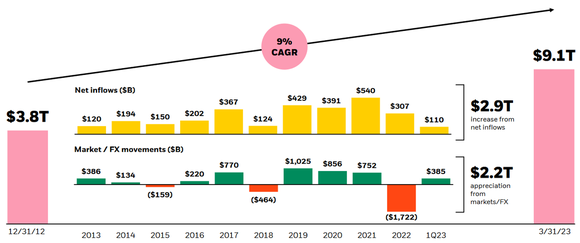There is some debate about whether we are in a new bull market. The S&P 500 is up 28% from its 52-week low in October 2022 but still down 6.6% from its previous all-time high close. As long-term investors, investors probably shouldn't get caught up in these relatively near-term market fluctuations. Instead, they should remember that bull markets tend to last three and a half times longer than bear markets.
One group that does take note of market fluctuations is asset managers. These investing experts manage funds on behalf of clients and tend to be big beneficiaries during economic expansions and bull markets. These companies earn fees on the total amount of assets under management (AUM), so when these assets grow during expansions, their fees do, too.
The steady revenue stream they receive also makes asset managers solid dividend stocks.

Image source: Getty Images.
Understanding the different types of asset managers
There is an ongoing debate in the investing world between active versus passive investing. Active investments are funds run by portfolio managers who try to outperform some benchmark index, such as the S&P 500, over time. Managers of these funds use in-depth research and market forecasting to make investments to try to deliver market-beating returns. Because these investments require more active management, they tend to be more expensive for investors than passive funds.
Passive investments are funds that aim to match, not beat, an index's performance. These funds attempt to replicate an index and often use exchange-traded funds (ETFs) to accomplish this. For instance, an ETF like the SPDR S&P 500 ETF matches the portfolio allocations of the S&P 500 index. Passively managed funds became popular over the last decade as ETFs became more prevalent. These funds tend to charge much lower fees for investors -- which can make a difference in performance over a decades-long investment horizon.
BlackRock (BLK +0.00%) and T. Rowe Price (TROW 0.01%) are two asset managers that operate at opposite ends of this investment spectrum, and both could make excellent additions to your portfolio today. Here's why these two asset managers are worth consideration this month.

NYSE: BLK
Key Data Points
1. BlackRock is the world's largest asset manager
When it comes to managing assets, no one does it at the scale of BlackRock. With over $9.4 trillion in AUM, BlackRock is the world's largest asset manager, ahead of Vanguard ($7.3 trillion) and Fidelity ($3.9 trillion). BlackRock's key to success is its wide array of investment products for clients, many of which are passively managed.
BlackRock wasn't always the behemoth asset manager it is today. Its purchase of the iShares brand, which it acquired from Barclays in 2009, put it on the map. Before that, BlackRock was the fourth-largest asset manager, with $1.1 trillion in AUM.
This strategic acquisition was a genius move in retrospect. It kick-started strong growth in AUM as customer preferences shifted away from active management and more toward index and ETF products with lower fees. Today, BlackRock provides over 1,250 ETF products that cover investments in equities, fixed-income, real estate, and other alternative investments.

Image source: BlackRock. CAGR = compound annual growth rate.
Last year, the asset manager saw AUM fall, primarily due to weakness in the stock market. However, its diverse investment options helped it rake in another $307 billion of net inflows last year. One reason it saw robust inflows was its fixed-income products. BlackRock's ETFs include products in Treasury bonds, municipal bonds, and investment-grade debt. These bond ETFs also span the yield curve, which investors can use to shift to safe-haven assets during times of uncertainty.
BlackRock achieved steady growth in AUM over time and is continually adding to its investment products. The company projects that the ETF industry AUM could grow to $25 trillion by 2030, up from $10 trillion in the first quarter of this year. It also has a 2.8% dividend yield it has grown annually for 14 consecutive years.
BlackRock's vast array of investment products and excellent long-term growth opportunities make the asset manager a solid buy today.

NASDAQ: TROW
Key Data Points
2. T. Rowe Price is an active manager that has done well despite passive trends
T. Rowe Price focuses more on actively managed investments through its family of mutual funds. With nearly $1.4 trillion in AUM, T. Rowe is the 10th-largest asset manager in the U.S.
T. Rowe Price has been on the opposite side of investment trends over the last decade. According to data from Statista, actively managed funds accounted for 57% of total assets in 2021, down from 79% just 10 years earlier. Despite these headwinds, T. Rowe has grown its AUM by 10% annually, thanks to the strong investment performance of its funds.
When it comes to the trends in investing, it's too soon to say active management is dead. Active funds can outperform their passive counterparts during different market cycles. According to research from Hartford Funds Management Group, active managers have outperformed in 18 of the last 35 years. A lot of this outperformance has come during challenging market environments, such as 1999-2005 and 2007-2009.
T. Rowe Price is a top-notch asset manager. The company has a strong balance sheet with over $2.2 billion in cash and cash equivalents and no long-term debt. It has also done an excellent job of navigating market cycles for decades, as evidenced by its 38-year history of raising its dividend payout. While T. Rowe may not see the same growth as BlackRock, it has proven to be a reliable source of cash flows over time -- making the asset manager another solid stock you can add to your portfolio today.